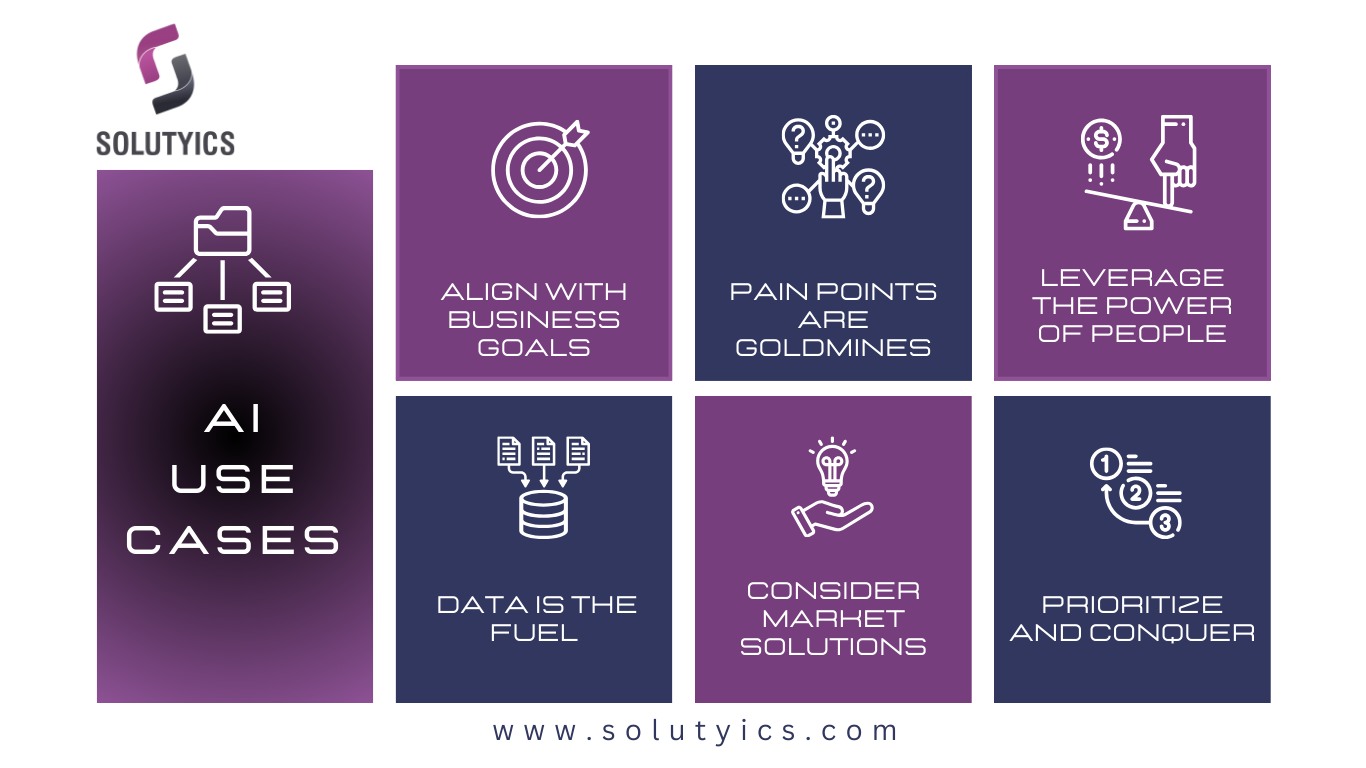
Identifying AI Use Cases in Your Organization.
Artificial intelligence (AI) is rapidly transforming industries, and organizations are eager to harness its power. But with so much hype surrounding AI, it’s crucial to identify the right use cases for your specific needs.
Here’s a roadmap to help you uncover the areas where AI can deliver real value:
- Align with Business Goals:
AI shouldn’t be an afterthought; it should be a strategic weapon in your arsenal, designed to propel your organization towards its goals. The key to success lies in aligning your AI initiatives with your overarching strategic objectives. Clearly define what your company is trying to achieve in the next few years. Are you aiming to increase revenue, improve customer experience, or streamline operations? Once you have a firm grasp on your strategic goals, you can begin exploring how AI solutions can bridge the gap between your current state and your desired future.
Here’s how to ensure your AI initiatives are laser-focused on achieving real business impact: Before diving headfirst into AI solutions, take a step back. Clearly define your company’s overarching strategic objectives. What are you trying to achieve in the next 3-5 years? Here are some common areas where AI can significantly impact strategic goals:
• Revenue Growth: AI can personalize marketing campaigns, optimize pricing strategies, and automate lead generation, all leading to increased sales and market share.
• Enhanced Customer Experience: Chatbots powered by AI can provide 24/7 customer support, while recommendation engines can deliver hyper-personalized product suggestions.
- Pain Points are Goldmines:
Look for the bottlenecks and inefficiencies plaguing your organization. Are there repetitive tasks that drain employee time? Is decision-making hampered by a lack of data insights?
• Go beyond the obvious: Don’t just focus on manual data entry or basic calculations. Look for hidden inefficiencies. For example, in the legal industry, AI can analyze vast case files to identify legal precedents that lawyers might miss during traditional research, saving them significant time and effort.
• Embrace Brainstorming: Conduct workshops where employees from different departments can share their frustrations and challenges. Encourage creative thinking – how could AI make their jobs easier, faster, or more impactful?
- Leverage the Power of People:
Involve your employees! Conduct workshops or surveys to understand their daily challenges. Frontline workers often have the most nuanced understanding of operational hurdles. Their insights can be invaluable in pinpointing areas where AI can provide real improvement.
• Skills Gap Analysis: Identify tasks that are well-suited for automation through AI. This can free up employees to focus on higher-level cognitive tasks that require creativity, empathy, and strategic thinking.
• Change Management is Key: AI shouldn’t be seen as a threat to jobs, but as a tool to empower employees. Invest in training and communication to ensure a smooth transition and foster employee buy-in.
- Data is the Fuel:
AI thrives on data. Before diving in, assess your data landscape. Is the data you need readily available? Is it of sufficient quality and volume to train an effective AI model? Remember, “garbage in, garbage out” applies to AI too.
• Data Collection and Cleaning: Identify the data sources you’ll need to train your AI model. Ensure the data is accurate, complete, and relevant to the problem you’re trying to solve. Inaccurate or incomplete data can lead to biased or unreliable AI outputs.
• Data Security and Privacy: As you collect and store data, prioritize data security and privacy. Ensure you have the necessary safeguards in place to comply with relevant regulations.
- Consider Market Solutions:
Don’t reinvent the wheel! Research existing AI solutions that align with your needs. Many pre-built AI models and platforms are available, potentially saving you development time and resources.
• Proof of Concept: Before committing to a large-scale AI implementation, consider running a pilot project with a pre-built solution. This allows you to test the effectiveness of AI in your specific context and identify any potential challenges.
- Prioritize and Conquer:
Not all use cases are created equal. Evaluate each potential application based on factors like:
• Business impact: How significantly will AI improve your bottom line or customer satisfaction? Quantify the potential benefits whenever possible.
• Technical feasibility: Do you have the necessary infrastructure and expertise to implement the solution? Be honest about your organization’s technical capabilities and plan accordingly. You may need to invest in additional resources or partner with a qualified AI development firm.
• Resource requirements: What investment will be required in terms of time, personnel, and budget? Be realistic about the resources you have available and prioritize use cases that deliver the most value within your constraints.
By following these guidelines, you can embark on a strategic journey of AI adoption. Remember, AI is a powerful tool, but it’s your organization’s goals and challenges that should ultimately guide your use case selection. With careful planning and a focus on real-world application, AI can unlock significant value for your organization.
FOLLOW ME
Mobile Apps
Lorem ipsum dolor sit amet, coctetur adipiscing elit.
Creative Websites
Lorem ipsum dolor sit amet, coctetur adipiscing elit.
SEO Optimization
Lorem ipsum dolor sit amet, coctetur adipiscing elit.
Brand Solutions
Lorem ipsum dolor sit amet, coctetur adipiscing elit.
